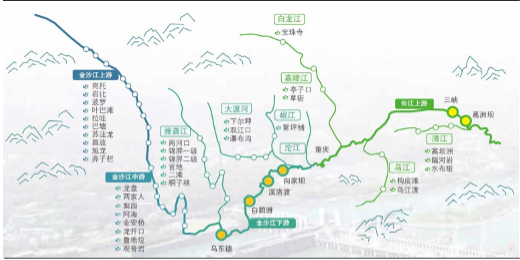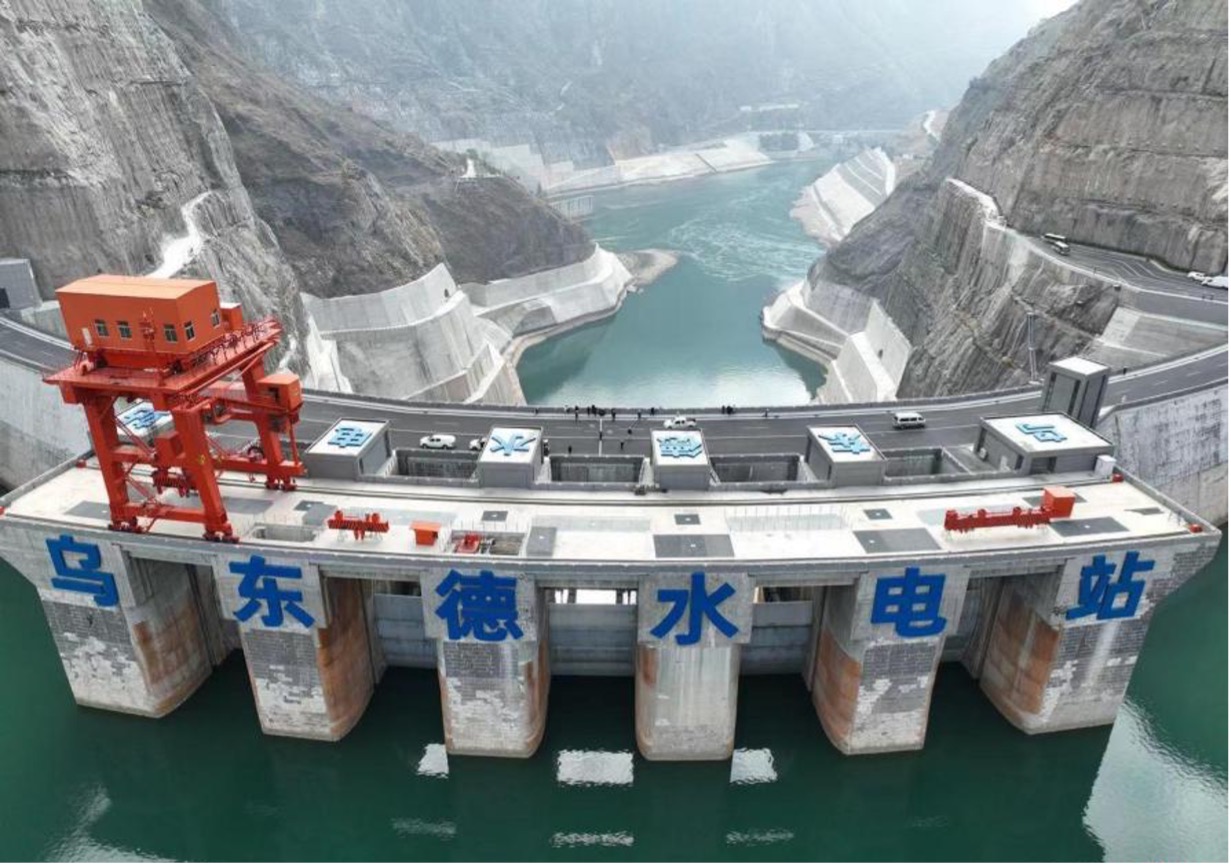Wudongde Hydropower Station
发布时间:2025年03月31日
浏览数:445
1. Project Background and Engineering Overview
The Jinsha River, with an average annual flow of 4,750 m³/s and a total drop of 3,300 meters, possesses abundant hydropower resources. It is the largest hydropower base in China and plays a key role in the West-to-East Power Transmission project. The lower reaches of the Jinsha River are home to four massive cascade hydropower stations: Wudongde, Baihetan, Xiluodu, and Xiangjiaba. These stations collectively have a total installed capacity of 42.1 million kW and an annual electricity generation of 184.3 billion kWh, which is equivalent to two Three Gorges plants[1].
Wudongde Hydropower Station is located in the dry, hot valley of the Jinsha River, with high temperatures, significant evaporation, large diurnal temperature fluctuations, frequent cold snaps, and high winds. The average annual temperature is 20.9°C, with a peak monthly average of 26.9°C (July) and extreme temperatures reaching 45.1°C (June 2014) and -0.4°C. During the summer months (May-August), the valley’s average temperature is around 30.9°C. Data from 2014-2017 show that extreme wind and humidity conditions occur between February and April, with relative humidity often dropping to 20%-37%, and winds exceeding level 7, accumulating 40-70 hours per month[3]. Under these extreme conditions, the concrete temperature control and crack prevention of the ultra-thin high-arch dam have posed a significant global challenge. To overcome this internationally recognized technical bottleneck, the project team innovatively adopted a low-heat cement concrete system for the entire dam, setting a new standard for the construction of ultra-high arch dams in complex climatic conditions.
(1) A Material Revolution in the Hot and Dry Valley
To meet the design requirement of a concrete crack safety factor greater than 2.0, the Wudongde team introduced a low-heat cement + 35% Grade I fly ash concrete mix for the dam [4]. This made Wudongde the first ultra-high arch dam globally to be constructed entirely with low-heat cement concrete. Low-heat cement is part of the silicate cement series, primarily composed of C₂S (dicalcium silicate). The team optimized the mineral composition, controlling the C₃A (tricalcium aluminate) content to less than 3%, and applied special ion doping technology to develop C₄AF (tetra-calcium aluminoferrite), enhancing the low-heat cement’s strength, durability, erosion resistance, and crack resistance. Furthermore, the low-heat cement exhibited lower early hydration heat, delayed peak temperature, a smoother heat release process, and a longer heat release period. The overall hydration heat release at different ages was significantly lower than medium-heat cement and ordinary Portland cement, effectively avoiding the "tail-end rise" phenomenon caused by hydration heat[3].
The widespread application of low-heat cement at Wudongde not only provides valuable experience for future hydropower projects with large concrete volumes but also offers crucial insights for the scientific planning and construction of similar projects. This development signals the promising potential and far-reaching impact of low-heat cement technology in hydraulic engineering.
(2) Temperature Control Challenges at the Millimeter Level
Scientific and rational temperature control was a critical technical challenge for the construction of the Wudongde arch dam in the dry-hot valley. The dam's complex structural characteristics—wide base, steep slopes, and narrow riverbed—led the team to adopt a full-year grouting construction method. This created a vertical temperature gradient within the dam, resulting in thermal stress in the non-constrained sections, similar to the stress experienced by the foundation-constrained sections. This approach meant that the entire dam remained in a "constrained state"[5] throughout the construction period. If not properly controlled, the temperature gradient could generate significant thermal stress, leading to cracks and compromising the dam’s durability.
Temperature simulation studies revealed that temperature stress in steep slope sections correlated positively with slope gradient, with the maximum temperature having a significant impact on the dam's thermal stress. For every 1°C reduction in temperature, the maximum stress could decrease by 0.1-0.3 MPa [3]. To prevent structural cracks caused by uneven temperature distribution, the team implemented dynamic temperature control standards: During the stage when the dam is still in contact with the bedrock (before it is fully released from the foundation constraint), the maximum concrete temperature was strictly controlled at 23°C. After the dam detached from the foundation, the temperature could rise to 27°C. In the transition zone between the dam structure and the foundation-constrained area, a middle-range control of 25°C was applied[3]. This dynamic temperature control system ensured stringent temperature management in the steep slope sections while balancing construction efficiency with structural safety.
References
[1] https://baike.baidu.com/item/Jinsha-River-Hydropower-Base/8584639
[2] https://baike.baidu.com/item/Wudongde-Hydropower-Station/9047665
[3] Hu, Q. B. (2023). Comprehensive application of low-heat cement in the Wudongde dam project. Yunnan Hydroelectric Power, 39(04), 184-192.
[4] Zhou, S. H. (2021). Long-term performance testing of Wudongde high-arch dam concrete. Yangtze River Science Institute Journal, 38(10), 156-160.
[5] Liang, R. Q. (2014). Research on temperature control and crack prevention for high-arch dams in dry hot valley regions. Yangtze River, 45(17), 42-45. DOI: 10.16232/j.cnki.1001-4179.2014.17.013.
The Jinsha River, with an average annual flow of 4,750 m³/s and a total drop of 3,300 meters, possesses abundant hydropower resources. It is the largest hydropower base in China and plays a key role in the West-to-East Power Transmission project. The lower reaches of the Jinsha River are home to four massive cascade hydropower stations: Wudongde, Baihetan, Xiluodu, and Xiangjiaba. These stations collectively have a total installed capacity of 42.1 million kW and an annual electricity generation of 184.3 billion kWh, which is equivalent to two Three Gorges plants[1].
Figure 1. Schematic Diagram of Jinsha River and Yangtze Cascade Hydropower Stations (Source: China Fund News)
Wudongde Hydropower Station, the first in the four-station cascade on the lower Jinsha River, controls a drainage area of 406,100 km², accounting for 84% of the basin. Its average annual runoff is 116.4 billion cubic meters. The dam structure is a concrete double-curvature arch, with a crest elevation of 988 meters, a maximum dam height of 270 meters, and a base thickness of 51 meters. The thickness-to-height ratio is just 0.19, making it the thinnest 300-meter-class ultra-high arch dam in the world and the first in the world to apply low-heat cement concrete for the entire dam. The underground power station at Wudongde features 12 mixed-flow turbine generator units, each with a single capacity of 850,000 kW, totaling an installed capacity of 10.2 million kW. After full commissioning, the station's annual electricity output will reach 38.91 billion kWh, making it the largest single-unit capacity hydropower station in operation worldwide. Wudongde is not only a major national project under the "West-to-East Power Transmission" initiative, but also the fourth-largest hydropower station in China and the seventh largest in the world, crossing the 10 million kW milestone[2].
Figure 2. Aerial View of Wudongde Hydropower Station (Source: Sichuan Online)
2. Technological BreakthroughsWudongde Hydropower Station is located in the dry, hot valley of the Jinsha River, with high temperatures, significant evaporation, large diurnal temperature fluctuations, frequent cold snaps, and high winds. The average annual temperature is 20.9°C, with a peak monthly average of 26.9°C (July) and extreme temperatures reaching 45.1°C (June 2014) and -0.4°C. During the summer months (May-August), the valley’s average temperature is around 30.9°C. Data from 2014-2017 show that extreme wind and humidity conditions occur between February and April, with relative humidity often dropping to 20%-37%, and winds exceeding level 7, accumulating 40-70 hours per month[3]. Under these extreme conditions, the concrete temperature control and crack prevention of the ultra-thin high-arch dam have posed a significant global challenge. To overcome this internationally recognized technical bottleneck, the project team innovatively adopted a low-heat cement concrete system for the entire dam, setting a new standard for the construction of ultra-high arch dams in complex climatic conditions.
(1) A Material Revolution in the Hot and Dry Valley
To meet the design requirement of a concrete crack safety factor greater than 2.0, the Wudongde team introduced a low-heat cement + 35% Grade I fly ash concrete mix for the dam [4]. This made Wudongde the first ultra-high arch dam globally to be constructed entirely with low-heat cement concrete. Low-heat cement is part of the silicate cement series, primarily composed of C₂S (dicalcium silicate). The team optimized the mineral composition, controlling the C₃A (tricalcium aluminate) content to less than 3%, and applied special ion doping technology to develop C₄AF (tetra-calcium aluminoferrite), enhancing the low-heat cement’s strength, durability, erosion resistance, and crack resistance. Furthermore, the low-heat cement exhibited lower early hydration heat, delayed peak temperature, a smoother heat release process, and a longer heat release period. The overall hydration heat release at different ages was significantly lower than medium-heat cement and ordinary Portland cement, effectively avoiding the "tail-end rise" phenomenon caused by hydration heat[3].
The widespread application of low-heat cement at Wudongde not only provides valuable experience for future hydropower projects with large concrete volumes but also offers crucial insights for the scientific planning and construction of similar projects. This development signals the promising potential and far-reaching impact of low-heat cement technology in hydraulic engineering.
(2) Temperature Control Challenges at the Millimeter Level
Scientific and rational temperature control was a critical technical challenge for the construction of the Wudongde arch dam in the dry-hot valley. The dam's complex structural characteristics—wide base, steep slopes, and narrow riverbed—led the team to adopt a full-year grouting construction method. This created a vertical temperature gradient within the dam, resulting in thermal stress in the non-constrained sections, similar to the stress experienced by the foundation-constrained sections. This approach meant that the entire dam remained in a "constrained state"[5] throughout the construction period. If not properly controlled, the temperature gradient could generate significant thermal stress, leading to cracks and compromising the dam’s durability.
Temperature simulation studies revealed that temperature stress in steep slope sections correlated positively with slope gradient, with the maximum temperature having a significant impact on the dam's thermal stress. For every 1°C reduction in temperature, the maximum stress could decrease by 0.1-0.3 MPa [3]. To prevent structural cracks caused by uneven temperature distribution, the team implemented dynamic temperature control standards: During the stage when the dam is still in contact with the bedrock (before it is fully released from the foundation constraint), the maximum concrete temperature was strictly controlled at 23°C. After the dam detached from the foundation, the temperature could rise to 27°C. In the transition zone between the dam structure and the foundation-constrained area, a middle-range control of 25°C was applied[3]. This dynamic temperature control system ensured stringent temperature management in the steep slope sections while balancing construction efficiency with structural safety.
References
[1] https://baike.baidu.com/item/Jinsha-River-Hydropower-Base/8584639
[2] https://baike.baidu.com/item/Wudongde-Hydropower-Station/9047665
[3] Hu, Q. B. (2023). Comprehensive application of low-heat cement in the Wudongde dam project. Yunnan Hydroelectric Power, 39(04), 184-192.
[4] Zhou, S. H. (2021). Long-term performance testing of Wudongde high-arch dam concrete. Yangtze River Science Institute Journal, 38(10), 156-160.
[5] Liang, R. Q. (2014). Research on temperature control and crack prevention for high-arch dams in dry hot valley regions. Yangtze River, 45(17), 42-45. DOI: 10.16232/j.cnki.1001-4179.2014.17.013.











 中国岩石力学与工程学会微信订阅号
中国岩石力学与工程学会微信订阅号
 科普岩石力学与工程
科普岩石力学与工程